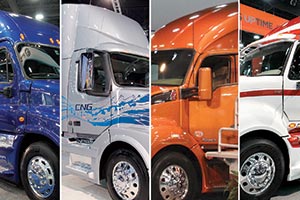US Delays Greenhouse-Gas Rule

This story appears in the April 6 print edition of Transport Topics.
LOUISVILLE, Ky. — The federal government has delayed the publication of a new greenhouse-gas emissions rule for trucks, a topic that was already top of mind for engineers, manufacturers and other industry leaders attending the Mid-America Trucking Show.
The U.S. Environmental Protection Agency and the National Highway Traffic Safety Administration now aim to publish their joint proposal in June, three months later than initially targeted.
The agencies sent the proposal for review to the White House Office of Management and Budget on March 27.
A final rule is expected to be issued next year.
All truck and engine makers addressed carbon emissions during industry events last month, including MATS, either by discussing the rule directly or by trumpeting advances in fuel mileage — a key strategy for cutting carbon dioxide.
Brian Mormino, executive director for environment and compliance at engine maker Cummins Inc., predicted that today’s heavy-duty truck engine architecture will not need to change drastically under the upcoming regulation. That consistency in engine structure will enable manufacturers to focus instead on improving efficiency and reliability for customers, he said March 25 at an ACT Research Co. seminar.
Mormino also said the government implemented its previous greenhouse-gas regulation last year “without a bump in the road.”
Martin Daum, president of Daimler Trucks North America, cited “very good talks” between the industry and government regulators.
“I’m fairly positive that we will get a good regulation,” Daum said. “The regulations we have at the moment are good, and let’s hope that the future is the same.”
The upcoming proposal will further reduce carbon limits to address climate change. It follows the inaugural fuel-efficiency standards for trucks that began in 2014 and will become more stringent in January 2017.
Bill Charmley, director of EPA’s assessments and standards division, said Phase 1 has not hindered truck sales, unlike earlier regulations.
“That’s very promising from our perspective because we are certainly not ignorant of what happened in 2002 and in 2007,” he said. “We’d like to learn from the past and see if we can develop both the Phase 1 program and the Phase 2 program in a way that can work for the market.”
Exhaust gas recirculation began in 2002. The 2007 change in emission technology gave rise to a dramatic “pre-buy,” with U.S. Class 8 retail sales spiking to 284,008 units in 2006 before quickly slumping to 150,965 in 2007, according to data from WardsAuto.com. The ripple effects from that event continue to be felt today in the used-truck market.
Charmley told Transport Topics that the rule’s implementation probably would begin around 2020 and continue to be phased in through 2025, or perhaps later.
Unlike the initial rule, the Phase 2 program is expected to include efficiency standards for new trailers.
Standards for dry and refrigerated trailers potentially could take effect earlier than 2020, Charmley said. The regulation likely will include a category for non-box trailers, including flatbeds and bulk trailers.
Beyond the regulatory particulars, manufacturers were eager to talk about improvements in fuel economy — the well-established strategy for decreasing carbon emissions. Alternative fuels, including natural gas, were also part of the discussion.
Navistar Inc. displayed its ProStar ES model, or efficiency spec, the components of which the company says do the most for mileage.
Peterbilt Motors said its Model 579 Epiq truck has been improved for better fuel economy. Likewise, suppliers to OEMs had their say, with axle maker Dana Holding Corp. offering options to improve mileage and almost all tire makers heralding their low-rolling-resistance units.
On Phase 2, Cummins’ Mormino said he expects the proposal to retain separate certification and standards for engines and vehicles, rather than moving to a full-vehicle standard only.
Cummins supports the separate-engine approach because it doesn’t interfere with competition among truck and engine makers while enabling strong enforcement for the engine benchmarks, he said.
In contrast, truck makers, particularly Daimler and Volvo, advocate for a complete-vehicle standard.
“A lot of the technologies, which today and will in the future save fuel, work together with other parts in the truck, so if you single out one component, it’s not necessarily optimum,” DTNA’s Daum said.
Volvo Group CEO Olof Persson also reiterated his company’s opposition to separate certification. “There are no loose engines pulling freight down the highways,” he quipped. More seriously, he said engineers prefer to look at a system as a whole to see how it can be improved.

